|
The abundance of water in Big Cypress National Preserve makes this ecosystem a haven for wading birds. As a result, these long-legged avians are some of the most commonly spotted birds in the swamp.
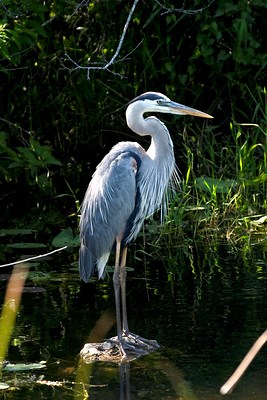
Appearance: Great Blue Herons are large, blue-grey birds with long legs, a long, slender neck, and a thick, pointed bill. A black stripe over their eye leads to a classy black head plume. An all-white variation of this heron can be found around the coast of southern Florida. Size: The largest heron in North America, Great Blue Herons can be up to 4.5 ft. in length with a 5.5-6.5 ft. wingspan. They can weigh between 4.6-6.4 lbs. Habitat: This bird nests in trees standing in or near water. They forage for food in grasslands and shallow water. Diet: Great Blue Herons will eat almost any small animal they can reach. They hunt by standing still or walking slowly along, darting their bill out to grab or stab their prey. Their diet includes insects, amphibians, reptiles, fish, birds, and small mammals. Reproduction: Great Blue Herons nest in colonies that can consist of hundreds of nests. A new mate is chosen every year, but once chosen the pair will usually remain monogomous for the entire breeding season. The female lays 2-6 eggs that are incubated for approximately 4 weeks. Both the male and female incubate the eggs and feed the young once they are hatched. 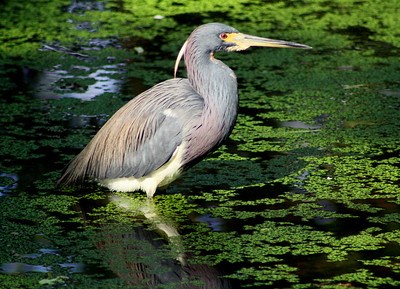
Appearance: These colorful herons have a mix of blue-grey and lavender on their head, neck, and back with a white stripe running down the middle of their neck to a white belly. They undergo color changes during breeding season (Feb-Aug), with their long, yellow legs turning pink and the yellow skin surrounding their bill turning blue. Juveniles have reddish feathers on their wings, neck, and back. Size: Tricolored Herons have a 3 ft. wingspan and are approximately 2 ft. in length. They weigh around 0.8-0.9 lbs. Habitat: These herons nest in trees standing in water or on islands. They forage in shallow water, both fresh and salt. During the breeding season they are usually found near saltwater. Diet: Tricolored Herons feed primarily on small fish. They will use a variety of techniques to hunt their prey, including standing still and waiting for prey to pass by, walking slowly, stirring up the bottom with one foot, actively chasing after fish, and pushing their wings above their head to create a shaded area to attract fish. Reproduction: Tricolored Herons nest in colonies, often with other species of herons and egrets. They are monogamous through the breeding season and possibly longer. The female lays 3-5 eggs that are incubated for 3-3.5 weeks. Both parents are involved in the incubation and feeding of the nestlings. 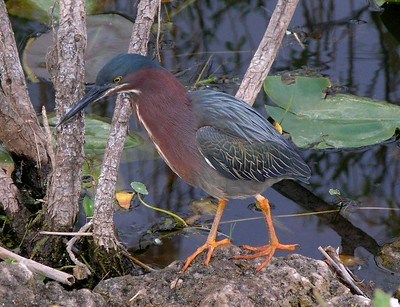
Appearance: This small, stocky heron displays a patchwork of colors with its dark green back and crown, reddish neck and breast, and dark grey wings. Their crown feathers can be raised to create a small crest. Juvenile Green Herons have a streaked neck and pale spots on their wings. Size: Green Herons are 1.3-1.5 ft. in length with a wingspan of around 2.1-2.2 ft. They weigh approximately 0.4-0.5 lbs. Habitat: These herons nest in dense trees and shrubs near water. They forage in and along shallow water, usually in thick vegetation. Diet: Green herons feed primarily on fish, although they will also consume insects, crustaceans, snails, amphibians, reptiles, and rodents. When foraging they will stand still or walk slowly along, lunging to grab their prey. Occasionally, this bird can be seen dropping small objects, such as sticks and feathers, onto the water surface as bait to lure in fish. Reproduction: Unlike many herons in the preserve, Green Herons often nest alone, only occasionally joining nesting colonies. The female lays 3-5 eggs that are incubated for around 3 weeks. Both the male and female incubate the eggs and regurgitate food for the young. After leaving the nest, the juveniles may remain with their parents for a few more weeks, being fed while they learn to forage. 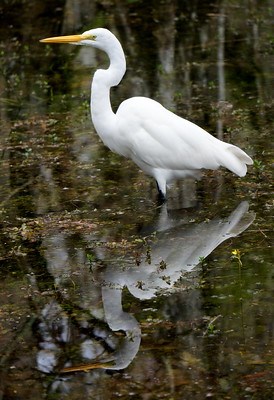
Appearance: Great Egrets are white with long, black legs, a long neck, and a yellow, pointed bill. During the breeding season both males and females grow long, feathery plumes on their back. Size: Though still one of Big Cypress' largest wading birds, Great Egrets are smaller than Great Blue Herons at 3.1-3.4 ft. in length with a 4.2-4.8 ft. wingspan. They weigh around 2 lbs. Habitat: Great Egrets nest in trees standing in water or on islands. They forage in shallow water and occasionally in upland habitats. Diet: To hunt, Great Egrets stand or walk slowly, waiting for prey to pass by. They can also use their webbed feet to stir up the bottom looking for food. Once found, they use their quick reflexes to snatch up their prey. Great Egrets feed primarily on small fish, but will also eat amphibians, reptiles, invertebrates, birds, and small mammals. Reproduction: Great Egrets often nest in colonies with other bird species. The male and female are monogamous through the breeding season. The female lays 1-6 eggs that are incubated for 23-27 days. Incubation and feeding duties are shared by both parents. While living in the nest, Great Egret hatchlings will threaten and attack any intruders to their home. 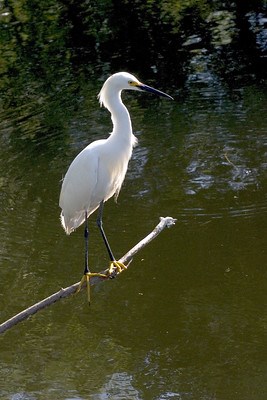
Appearance: Snowy Egrets live up to their name with their snowy, all white plumage. Adults also possess a pointed black bill with a patch of yellow skin at the base, long black legs, and bright yellow feet. Juveniles have greenish legs. Size: Snowy Egrets weigh around 0.8 lbs. They are 1.8-2.1 ft. in length with a 3-3.3 ft. wingspan. Habitat: These birds nest in trees standing in water or on islands, often changing locations between years. They forage in shallow water, both salt and fresh, and can sometimes be seen hunting in grassy fields. Diet: Snowy Egrets can often be seen foraging in groups with other birds, where they feed on small fish, frogs, crustaceans, and invertebrates. Their hunting techniques include actively chasing after prey, stirring with their yellow foot to flush prey out, hovering over the water, and standing and waiting for prey to approach. Reproduction: Snowy Egrets nest in colonies with other wading birds. The female lays 2-6 eggs that are incubated by both the male and female for 24-25 days. Both parents feed the nestlings by regurgitating partially digested food. 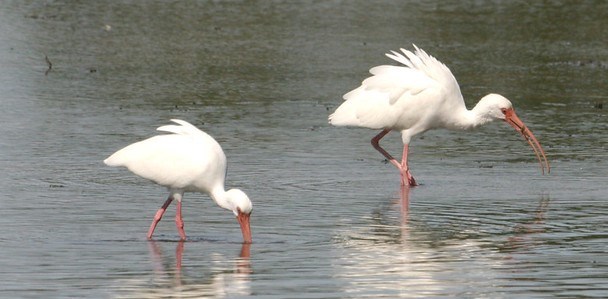
Appearance: Adult White Ibis are white with black wingtips, long legs, and a long, slender neck. Their red legs and long, curved, red bill set them apart from other white wading birds. Juveniles are brown with white undersides, a streaked brown neck, and a pale orange on their legs and bill. During their first summer, young ibis appear as a patchwork of white and brown as they molt into their adult plumage. Size: White Ibis are around 1.8-2.2 ft. in length with a 3.1-3.5 ft. wingspan and weigh approximately 1.5-2.3 lbs. Habitat: This species is often found in wetlands. It nests in shrubs and small trees near water and forages in wet areas and shallow water. White Ibis can also often be seen foraging on lawns. Diet: White Ibis feed primarily on insects and crustaceans, with fish, frogs, lizards, snails, and snakes also playing a role in their diet. They forage by probing the ground with their bill to feel for prey or by snatching up prey they see above ground. Reproduction: White Ibis nest in colonial groups. Males and females form pairs, but males will often mate with multiple females. The female lays 2-4 eggs that are incubated by both parents for up to 22 days. Both parents regurgitate food for the juveniles and continue to feed them for up to two months after they leave the nest while they learn to forage. 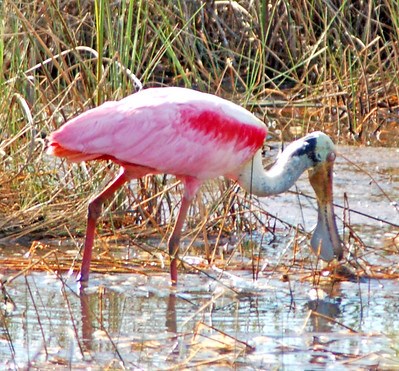
Appearance: Roseate Spoonbills are pale pink with a white neck, bright pink shoulders, and a pink-orange tail. Their long bill is round and flattened at the end, resembling a spoon. A naked, featherless head makes it easy to see their startling red eye. Juveniles are a paler pink than the adults and have feathers on their head for the first three years. Size: These birds weigh around 2.6-3.9 lbs. They are 2.3-2.8 ft. in length and have a 3.9-4.2 ft. wingspan. Habitat: Roseate Spoonbills breed primarily on the coast, with some nesting inland. They nest in shrubs and small trees near water and forage in shallow water (fresh, brackish, and salt) with a muddy bottom. Diet: Roseate Spoonbills feed on small aquatic crustaceans such as shrimp and crabs, aquatic insects, and small fish. Their pink color comes from carotenoids, a pigment found in their food. They forage by sweeping their partially open bill from side to side, using sensitive nerve endings on the bill to feel for prey. They will also pick up prey they have detected by sight. Reproduction: Roseate Spoonbills nest colonially with other species of wading birds. They form pairs for the breeding season but usually do not stay together beyond the season. The female lays 1-5 eggs that are incubated for approximately 22 days. Both parents incubate the eggs and feed the young. 
Appearance: Wood Storks are large, white birds with black tails, black along the edge of their wings, and long, black legs with pink toes. Their distinctive head is bald, along with their neck, and covered in dark, scaly skin. Their long, heavy, black bill curves at the tip. Juvenile Wood Storks have a light-colored bill that will darken over time and neck feathers that will be lost with age. Size: These massive wading birds can be 2.8-3.7 ft. in length with a 4.9-5.7 ft. wingspan. They weigh around 4.5-5.8 lbs. Habitat: Wood Storks nest in trees of forested wetlands (ex. mangroves and cypress domes/strands) over standing water. They forage in shallow wetlands, usually in more open areas. Diet: Wood Storks feed on fish, crayfish and other aquatic invertebrates, and will sometimes eat amphibians, rodents, seeds, nestlings, and reptiles, including baby alligators. They can hunt for prey visually but are most often seen walking slowly with their partly open bill in the water feeling for prey. When prey touches their bill, they snap their bill closed around it, swallowing it whole. Wood Storks will also move their feet or quickly move their wings to startle prey. Reproduction: Wood Storks nest in colonies with other wading birds. Mates are chosen at the breeding colony and remain together for the breeding season. The female lays 1-5 eggs that are incubated for approximately 30 days. Both the male and female incubate the eggs and feed the nestlings. For the first several weeks, the young are usually guarded by one of the parents to prevent attacks from unmated storks. |
Last updated: October 25, 2021
